2019-06-12 05:05:342019-06-13 13:28:30Patient’s hair color returned from white hair to dirty blonde in 6 months with benfotiamine
2019-06-12 05:05:342019-06-13 13:28:30Patient’s hair color returned from white hair to dirty blonde in 6 months with benfotiamine
Reprinted from the New Hair News, Vol. 12, 2007.
Click here to request your free copy, included with the “complete information package”.
—
People always ask, “How many grafts will I actually need to have transplanted?†Time and time again, that graft number answer will vary by doctor. When a doctor recommends a certain number of hairs/grafts, the doctor’s experience and his/her artistic skills are used to estimate what it might take to fill in the balding area with enough fullness to meet the person’s needs. I have seen estimates that could be a four fold difference and when you are shopping for a hair transplant, the differences in the estimating abilities of the doctors can be very unsettling. Who do you believe? Clearly you want to believe the doctor who has the lowest estimate for hair moved (transplants are priced by the graft), but then you are locking yourself into what might become a never ending series of hair transplant surgeries with an unrealistic amount of hair transplanted that may not meet your goals.
Does your doctor have the necessary artistic ability, not just to estimate the number of hairs/grafts, but also to take advantage of the hair supply to create a distribution that maximizes the value of the transplants for the most fullness? We have put some factors together to address how a surgeon actually calculates the numbers of grafts. These factors may not apply equally to all people. No two people are the same. The various factors like the thickness of the individual hair shafts (coarse vs. fine hair), the character of the hair (curly vs. straight hair), the color of the hair and the skin (the closer the match, the more full appearance of the hair), and any special needs defined by the patient, make us very different. On white skinned people, those with blonde hair have a fuller look while those with black hair will have a more ‘see through’ appearance. The blonde haired man, the very fine haired man, or the very bald man who has a hair supply that might not be adequate to cover the bald area will be different in their needs for fullness. When the calculations are not clearly evident, it is the doctor’s art that saves the day to maximize the value of the hair transplants that are received. We generally try to restore 25% of the original hair density in a ‘typical’ patient. Some people may require more than 25% of the original density and if you are one of these people, you should understand what you need and why you need it. Even if the overall achieved density is 25%, some areas may require more and some less than 25%. In people with fine or dark hair and light skin, a higher density than 25% of the original density is often required. In blondes with fair skin, less than 25% of the original density might meet the ‘fullness’ requirement. This is critical, because you look for fullness in the end result of the transplant process and it is the doctor’s art that addresses just how that fullness is to be achieved. Keep this in mind as you look to the analysis below.
The math for estimating number of grafts needed for a bald area:
We have proposed a 25% rule, which means that the balding person can go from a completely bald area to 25% of the original hair density that was there prior to the balding. The following calculation also assumes that the person used in this example has an average density of 2 hairs/mm2 (average density of a Caucasian). Every person is different, so the final number of grafts that will produce the fullness that a person wants to achieve (and can afford to purchase), are independent variables. These calculations were originally defined in a classic medical journal article written by Rassman in 1993 (Rassman, W.R.; Pomerantz, M.A. Minigrafts, the art and science. International Journal of Aesthetic and Restorative Surgery. 1(1): 27-36; 1993).
by William R. Rassman, M.D. and Jae P. Pak, M.D.
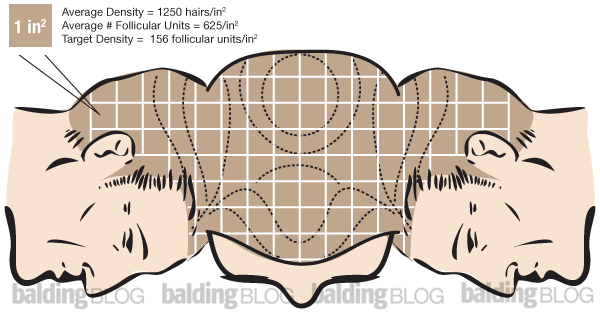
“As a professional consulting engineer, I have been trained over many years to appreciate the importance in the details. For example, when I decided to investigate hair transplant options for myself, I took my time; the overriding litmus test, was “A bad hair transplant result is far, far worse, than having no hair transplant at all, at any price”. That principal first led me to start at the very beginning… Who developed the first successful thousands at a time hair transplant procedure that was a completely successful result? Wikipedia will lead you directly to Dr Rassman. He was the original pioneer in this thousands at a time hair transplant procedure. I was hoping to find a doctor who had been trained by Dr Rassman; and to my surprise, I found Dr Rassman was still practicing! I immediately arranged to see him, for a procedure. He was hands on for the whole procedure, including his office staff professionally trained by him to totally exacting standards. Before this, my long term hair stylist for many years had cautioned me not to get the hair transplant; he had seen so many horrible results in the past. So it was with great surprise my hair stylist upon seeing me the first time after the procedure, couldn’t believe how natural my new hair line looked! That is the best feeling when I heard my hair stylist’s disbelief. Apparently, hair transplant results in North America are getting worse over these years, as more and more “Less than competent” doctors are doing unskilled procedures, only for the money. Do not allow yourself to become another billable bad example of what not to do. Thank you to Dr Rassman and your amazing staff.”
This type of comment made my day and warmed my heart. He had 2460 grafts.
2020-01-06 13:40:312020-01-06 13:41:43Patient review from Italian Vacation (photo)
Here’s a man in his early 30s that was tired of looking older than he actually is, with a Norwood 3A pattern. We restored his hairline in just one procedure of 2000 grafts, and with the hairline came the youthful appearance we’re all after. The after photos were taken at around 11 months after his hair transplant. Click the photos below to enlarge:
After (1 procedure of 2000 grafts):
Before:
2011-12-15 14:56:152011-12-15 14:23:33Patient Results – Hairline Restoration with 2000 Grafts (with Photos)
This patient is a doctor and appreciates the radical change in his hair over the past 9 months since he had his hair transplant. He told me that no one specifically noticed the change as his hair was growing in, but knew there was something going on that made him look around 10 years younger.
Some thought he was just exercising and eating better. He said that even when friends looked at his head, it wasn’t apparent to any of them that he had been growing hair where he was previously bald. But comparing his current look to his before photos, the change is quite apparent now.
Click the photos to enlarge.
After (2781 grafts in 1 procedure):
Before:
2012-10-19 14:30:432012-10-19 12:56:26Patient Results – Amazing Change in Just 9 Months After 2781 Grafts (with Photos)
This well known Los Angeles radio host has an advanced Class 6 balding pattern. The bald area is huge (as well as his hat size), and the 2700 medium weight hair grafts were distributed so that it would take advantage of weighting to cover the large balding area. In other words, more hair was placed in the front and on the left side than elsewhere. Utilizing weighting so that a left to right combing style could be used to maximize the value of the 2700 graft he received in his first session, he remained see-through in the central and right areas of his scalp where the amount of hair was not great.
Had we been able to remove 4000-5000 grafts safely, we could have filled up the central area and addressed what was to be thin coverage. As you can see in the pictures, the coverage was good for that number of grafts, but he needs another session to complete the process, bringing up the number of required grafts to the 5000+ range.
If you look at our photo albums, you will see many patients who had 3500-5500 grafts to cover the Class 6 pattern adequately. We are limited to what can be safely transplanted in each session. Still, when you look at the photos below, the change with strict styling and the use of a comb-over produced a remarkable change in his appearance and he is very happy with stage one of what will certainly be a two stage process.
Click the photos to enlarge.
After (1 procedure of 2700 grafts):



Before:
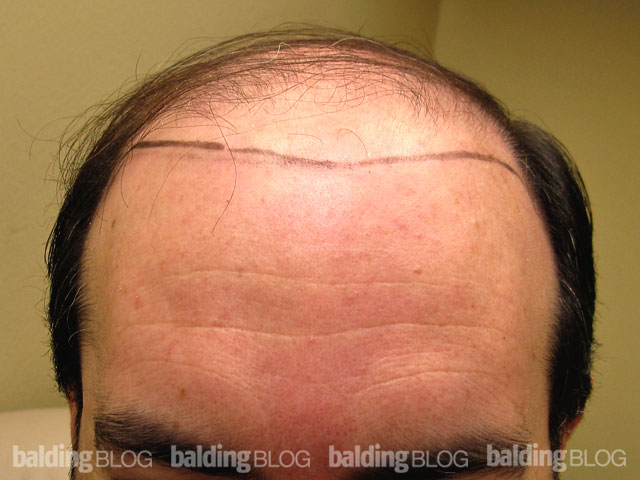
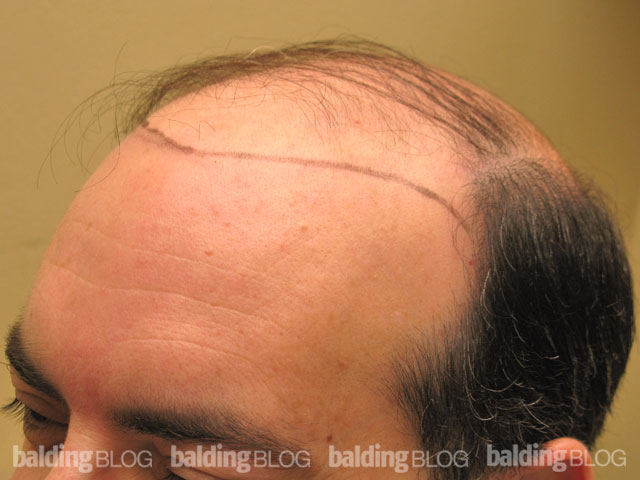
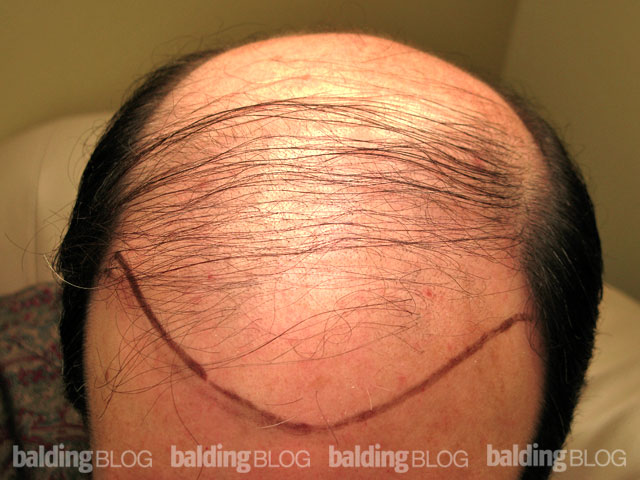
Bonus – head shot:
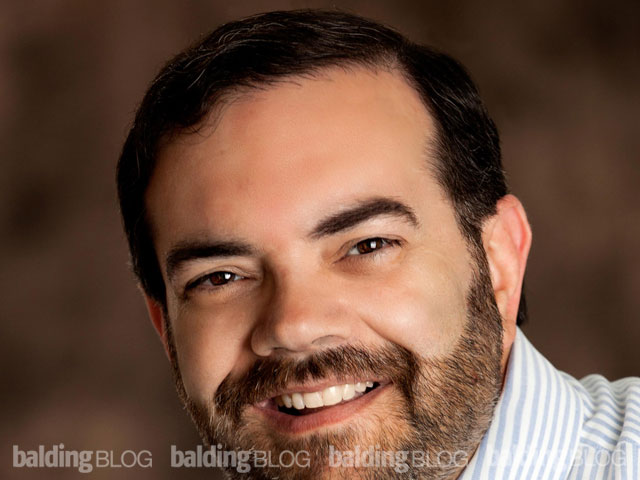
This post comes from Dr. William Parsley in Louisville, KY:
Just saw this fellow (around 50 yrs old) today for follow up. I placed him on 1/4 tab of Propecia QD (0.25mg) along with Rogaine Foam BID a year ago. Attached are his results. Don’t know if he would have had a much better result with a higher dose. The appeal of a very low dose got him to give it a try, as he wasn’t excited about using it for worries about side effects. He had no side effects fortunately.
Click the photos below to enlarge:
After (1 year of 0.25mg finasteride and Rogaine Foam):
Before:
If you really had 6000 grafts, the doctor should have spread it throughout your head, not concentrate it in the front and sparsely place it behind throughout the remaining balding scalp, I don’t know what your doctor was thinking. To find out exactly what he did, ask your doctor for a copy of the surgical record and the count sheet as that will tell you what you actually got because I am having difficulty believing that there is 6000 grafts there.
2020-09-18 03:24:382020-09-08 09:52:38Patient questions if he really got 6000 grafts (photo)
2018-01-05 06:46:112017-12-27 17:47:58Patient presents with pimples and a pink color throughout the recipient area at 20 days (photo)